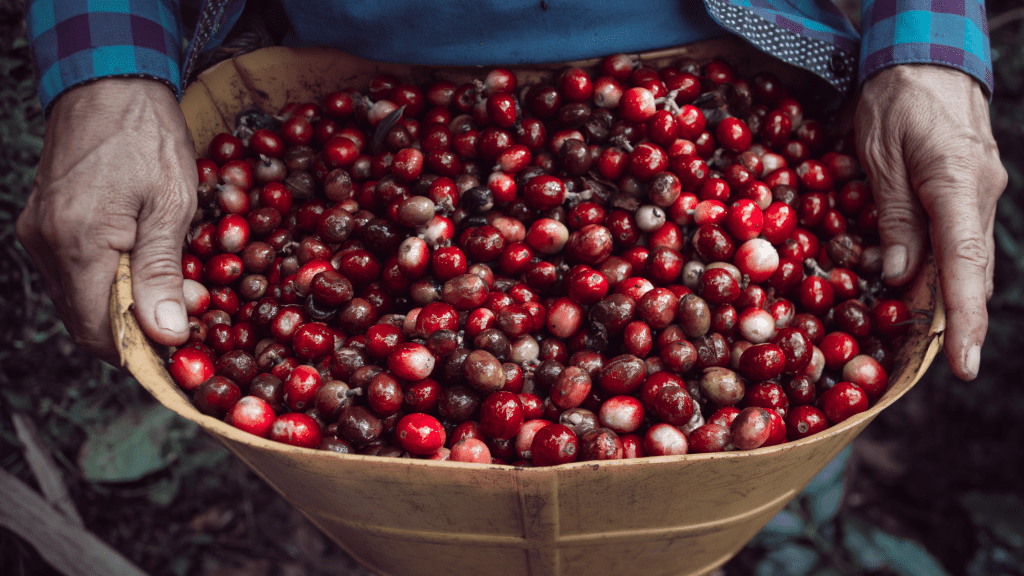
Will it be fair to call yourself a coffee enthusiast if you don’t really know how coffee is harvested? Absolutely NOT! But don’t worry, I’m here to give you coffee insights and not guilt trips. So here’s everything you need to know about harvesting a coffee.
Ripened coffee cherries are usually harvested in the bright sunny months in two ways including Strip Picking and Selective Picking. Both have completely different processes and agendas. Plus, there are also sub-categories under strip picking, known as manual and mechanical.
Along with the methods, you should also know about things around them. Like how long it takes, what happens to the beans after harvesting, the right season of harvesting, and so on.
So if you don’t want to turn red like a coffee cherry when next time someone throws a coffee-harvesting trivia at you, keep on reading!
Selecting & Stripping- The Two Main Methods Of Harvesting Coffee
Table of Contents
Strip picking and Selective picking are the two popular harvesting methods adopted by the majority of the elite coffee estates around the globe. Let’s take a deep dive and learn how they are done.
Selective Picking
You might have heard many coffee commercials say that the beans are “hand picked,” Well, selective picking is what they use!
In selective picking, the pickers carefully hand-pick only the ripe coffee beans and leave the ones that are not ready yet. The unripened ones are left unharmed till future harvesting.
For the beans that are over-ripped, the pickers either leave them (not the right approach) as it is or pick them up and collect them separately.
In selective picking, the picker visits the fruits every other week and continues harvesting the ripe ones until the producer orders them to stop. Each picking session takes an entire day, and at the end of the day, the pickers spread out the fruits and segregate any leaf, debris, or unripened/ overripe fruit that has accidentally made its way into the good pile.
Once the good pile is thoroughly checked, it is sent for weighing and packaging.
Pros
- The coffee cherries are precisely picked, so you only get the ripe ones. As a producer, it is great. The lower the number of unripe/ overripe beans, the better the quality of the batch. So they get to charge more for serving quality.
- Hilly regions have the suitable climate for growing high-quality coffee cherries, but the topography is what makes it hard to work around.
This process of harvesting involves no such machines in the picking phase. Therefore, the coffee trees can also be planted in a sloping area. This way, more land can be used in an efficient way.
Cons
- It takes A LOT of physical labor.
- A big chunk of the profit goes into labor charges.
- It can be tricky for the pickers to only pick the ripe ones and not disturb the unripe ones. It is almost like an art that takes time to master.
- As urbanization is increasing, the number of laborers who are willing to do this job is decreasing. So the owners face a significant labor shortage, and the problem seems to only increase in the future.
These cons are big roadblocks if someone is aiming to upscale their coffee production business. Also, this harvesting technique may not work for commercial coffee producers.
Hence, they opt for a more cost-effective method, which is strip harvesting.
Strip Harvesting
Strip harvesting is a one-shot thing. The pickers harvest all the berries at once, leaving no fruit behind. Meaning they pick ripe, unripe, and overripe cherries altogether.
Usually, this method is only used for Robusta coffee, as Arabica is considered more precious. This type of harvesting is more convenient for places where coffee estates are built on plain lands (i.e., Brazil).
Now strip harvesting can be done in two ways: manually and mechanically.
a) Manually:
In manual stripping, the pickers will place a net or canvas around the trunk of the coffee trees and knock the berries down, one branch at a time. To pull the berries out, they grab a branch and pull the cherries in an outwards motion.
Manually Strip Harvesting Coffee Cherries
Once all the branches of a tree are done stripping, the pickers carefully wrap up the canvas or net and transfer the coffee cherries to bags for weighing.
b) Mechanically
In mechanical stripping, instead of using hands, the pickers take the help of fork-like tools. The tool looks as if someone has attached the hands of Freddie Kruger to a string trimmer.
The pickers comb through the branches with this machine and collect the cherries in the same way as they do in hand striping.
Pros
- Takes less labor.
- Saves more time.
Cons
- Cherries of different maturity are picked together. Hence the sorting needs to be done very carefully.
- A lot of unripe coffee cherries go to waste.
- To sort the fruits correctly, the harvesters might need to invest in high-quality technology that gives precise results. Or else beans of different maturity will lead to a lower quality product.
These two techniques are great for a business that targets premium customers or someone who wants to grow and harvest coffee on their own.
However, these two harvesting methods, one way or another, decrease the profit to great levels, and commercial growers can not afford that. As they are both time and labor-consuming, commercial growers take the help of a different coffee harvesting process.
This technique is different from both selective and strip harvesting, so it makes sense to give it a separate category. It is called mechanical harvesting.
In short, they use a huge sieving machine that is attached to a tractor. The harvesters put the branches from one end of the sieve, and it segregates the cherries from the leaves and branches.
Just like strip picking, they also collect cherries of different maturity in one go. Therefore, in the next stage, they also need to repeat the separation process. But the process is super fast and requires minimum physical labor. So the companies save a lot of money on that.
I will attach a video here for you to see how the process works.
How Long Does It Take To Harvest Coffee Cherries
Let me establish first that growing coffee is a task! If you are planning to plant coffee trees and build your own little coffee farm, know that it can take upto four years for a tree to just start flowering!
The trees can grow as high as 30 feet and can produce quality coffee cherries for 20 to 30 years, depending on how well you take care of them.
Once the trees have flowers, it can take from 8 months to a year for the coffee cherries to ripen and become ready for harvesting. You can easily tell when a coffee cherry is ready to be picked as it changes its color from green to red.
Do You Know The Right Time For Harvesting Coffee?
Honestly, it is quite a tricky question!
The harvesting season varies depending on the geographic location. Usually, there is a single harvest per year, but there are places where it is done twice a year.
To the north of the Equator, coffee harvests take place between September to March. Whereas in the southern half, the harvesting is done between April and May.
Countries like Kenya and Columbia harvest coffee cherries twice a year. The first one is called the main harvest, and the other one is a secondary crop. Apart from that, the harvesting period also changes with the type of beans.
For example, the harvesting window for Arabica is usually short. It falls between November and December (for the northern part of the Equator), but the window is longer for Robusta. It can stretch between October to January (for the northern part of the Equator).
Which Climate Is Suitable For Growing The Best Coffee?
In a word, tropical climate regions grow the best quality coffee.
The high altitude locations of tropical regions like Asia, Brazil, Africa, the Caribbeans, etc., have the climate that grows the best quality coffee.
For the finest Arabica coffee, the optimum temperature range is 18 to 21-degree celsius. Temperatures of more than 30 degrees can be damaging for coffee plants, resulting in yellowish leaves, stunting growth, and even spawning stem tumors.
The rainfall should be between 60 to 80 inches per year, along with a two to a three-month-long dry period. The warm, rainy season is when the trees grow rapidly, and the cool and dry months are when the berries get ripened and ready to be plucked.
Did you know that Arabica might be the older child of the (coffee) family who is more loved and adored, but Robusta has a higher caffeine level? So if you are looking for highly caffeinated coffee, you know who to pick.
The harvesting is always done in bright and sunny weather as harvesting is followed by processing and drying of the cherries.
What Happens When The Coffee Beans Are Picked?
If you thought growing and harvesting was the difficult part of making coffee, then you don’t know about the processing part yet! Just like picking, there are a couple of popular methods of processing beans, and here are the top three.
a) The Wet Wash Process
The coffee cherries need to be de-pulped immediately after they are picked, or else they will perish.
The maximum time window is of 10 hours, and under this time limit, the harvesters need to get done with the first step, which is de-pulping.
This step is also known as the washing/ wet-washing process. In this step, the freshly harvested coffee cherries are first pressure washed with water (which does the job of de-pulping the cherries) and then left in a tank for 18-24 hours for fermentation.
The natural fermentation process helps break down the mucilage surrounding the beans. Mucilage is a slimy and sugary substance that covers the seeds. Once they are fermented enough, the beans are then washed with fresh water to stop further decay.
Then they are sun-dried for 60 to 90 days and sent for shipping.
b) Natural Drying Process
The second most common method of processing coffee is cherries to dry them naturally. In this case, the bean is dried along with the fruit, and once they are de-pulped once the fruit is dried well.
The beans processed through this process tend to have more fruity and intense flavor as all the goodness of the beans stays locked for a longer time. Ethiopia is one of the most popular places using this processing method.
There is a subcategory of this drying process called the Wine process. In that, the harvesters don’t pick the coffee cherries and let them over-ripe on the shrubs. This gives the beans a slightly sweeter and fermented taste.
c) The Honey Process
This processing technique is mostly used around Costa Rica and El Salvador but is gaining popularity lately.
In this process, the cherries are de-pulped after harvesting but not that thoroughly. Bits of pulp and fruits are intentionally left to add an extra touch of flavoring. The beans give a creamier mouthfeel compared to wet-washed beans.
After a rough de-pulping, the beans are sent for slow drying and depending on how much pulp is left, the beans are classified as Yell, black, or Red Honeyed coffee.
And That’s How The Bean Reaches From The Farm to Your Cup
Now that you know how coffee is harvested, it is fair to say that the journey from seed to sip is quite a tricky one. It takes a lot of care and labor to grow the best-quality beans that are full of aroma and uniqueness.
Commercial growers can offer you the best prices, but you should always go to locals if the taste is what you are looking for. But that does not mean commercial coffee brands aren’t worth it. If you understand your taste buds, you can always find the perfect match for you!



